You are reading the older HTML site
Positive Feedback
ISSUE
20
july/august
zero one
Ti48 transport and Ar38 DAC
as reviewed by Danny Kaey

|
DANNY KAEY'S SYSTEM
LOUDSPEAKERS
ELECTRONICS
SOURCES
CABLES
|
Until now, you needed separate components to play recorded music. A source, a preamp and power amp (or integrated amp), and loudspeakers were the bare minimum. All of these components were engineered as stand-alone pieces of equipment, but the ever-increasing processing power of computers has changed all that. Virtually any $400 Dell or $500 Mac mini comes with just about everything you need to set up a music (and video) server/playback system in your home. The problem is that while you will be able to get decent sound from these packages, it will be far from what you can get from a decent high-end audio system. This is the problem Alvin Heng (along with an international team of experts including Tom Browne from England and David Broadhurst from New Zealand) set out to solve when he launched Zero One Audio. Although the company is registered in England and most business aspects are handled there, the manufacturing is done in Singapore. Alvin's goals were simple, yet lofty for such a small startup. He wanted to design a music playback system that had its roots deeply in the high-end-audio realm, yet that would allow a modular expansion into the possibilities of an all-encompassing digital home audio system. Heng believes, and I agree, that the time has come to introduce expertly designed products that fit into the modern digital lifestyle. The concept is similar to the one that Apple and Microsoft have been trying to implement for the past few years, with Apple having greater success due to the popularity of the astounding iPod, now in its fifth year of manufacture.
For those still in the dark ages, let me give a brief history lesson. Around 2000, music sales were down, pirates utilizing file-sharing software like Napster were trading millions of songs without paying royalty fees. Music execs were in a dilemma, and rushed to the Supreme Court to bring an end to the madness. Out of nowhere came Apple, until then lingering in near-obscurity. The company released the first iPod with a 5-gigabyte hard drive—a portable music player capable of playing anything from compressed mp3 files to DRM (digital rights management)-enabled AAC files to uncompressed AIFF to losslessly compressed files via earphones or directly into your "stereo." At the same time, they also released iTunes, the magical music-management software that ties it all together in a way that no one else seems able to replicate. Music execs scrambled to get on board, and a new star was born. In the U.S. alone, iPod and iTunes have sold more than 500 million songs to date, with the 50-million mark reached in Europe a few weeks back. Hovering around a market share of close to 80 percent, Apple seems to have built an almost perfectly synergistic package. It's the height of irony. Music giants like Sony and computer giants like Microsoft simply don't seem able to compete with Apple, an underdog if ever there was one. (To give you an idea of the proportions, Apple's R&D budget is around $600 million a year, while Microsoft's spent a staggering $5 billion last year. Apple has about $6 billion in the bank, while Microsoft has $80 billion.)
Similar ventures are being planned as we speak for the mother of all digital content—video. Once that happens, no one will be walking down to Tower Records to get music discs and videos. A click of the mouse will do the trick. Small, specialized stores will probably be around for many years to come, but most people will be downloading their content of choice via broadband. This is how we will arrive at the digital home. A centralized computer will act as the server of all this content, while smaller nodes will be acting as the delivery agents, all interlinked via WiFi. (Rumors have it that the next generation of iPods, V, will feature WiFi, Bluetooth, and perhaps video capabilities via the stupendously good H.264 video compression codec, which forms the basis of both next-generation HD-DVD and BluRay.) Will this mean the end of high-end audio companies? No, but I would strongly urge that the R&D departments of those companies start realizing that the industry desperately needs users to remain viable. My 11-year-old daughter has all her CDs copied onto her iMac. When I spin an LP or even a CD, she thinks I am being old-fashioned. Many of my non-audiophile friends have the means to spend the money required for a top-flight multimedia system, and many have done so. When they come to my place, they are very impressed with the sound of my "mere" two-channel system, but they leave yearning for their multimedia systems. Why? The simple answer is that computers have forever changed the way we interact with content. Dropping even an SACD into the best of players is not good enough for most of my generation, who grew up surrounded by computers. They don't care if the sound I get from my audio system is better than what you can get from a computer or a multimedia system. They want to have the content they want, the way they want it, whenever and wherever they want it.
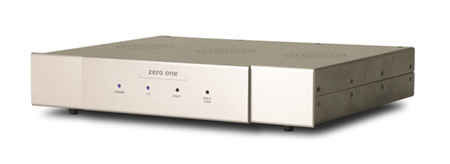
The Zero One Model Ti48 and accompanying Model Ar38 DAC is a music server, though not in the sense I have described—yet. It doesn't have WiFi, or multi-room remote capabilities, or a fancy, feature-rich user interface. It doesn't even have a fancy remote control. What it does have is a very well thought out and laid out design that has been executed to near perfection, within the context of a home-computer-based music playback system. Alvin calls the unit an "archival CD transport." Around the time when I took delivery of the Zero One combo, Alvin was in Southern California on a business trip, and I was able to sit him down for a one-on-one session to find out what this landmark product was all about. Among the first things I discovered was that most of the parts inside the Ti48 transport/server are off-the-shelf computer components—its Intel-based motherboard, a Pentium cpu, a pci sound card, two 250-gig hard drives, and a Toshiba tray loading CD-ROM drive are components you probably have in your computer. While you may think this is a run-of-the-mill computer at first, the $3960 factory-direct price (with 30-day home trial, excluding shipping and tax/duty charges) will make you think otherwise. Alvin explained that merely dropping these components into a box does not an audiophile-grade music server make, and I agree. Having embarked on a similar mission some time ago, I learned that computers are among the noisiest of environments for fragile, tiny audio signals.
Alvin explained that the main reason for this is the inherently noisy switch-mode power supply contained in most computers, as well as the myriads of ICs and other such devices that do the audio signal little good. His solution was as simple as it was ingenious—create a good solid power supply for all computer duties and supply the pci audio card with a separate, clean power stream. Finally, he isolated all non-relevant circuitry from the audio signal, and arrived at the quietest component I have ever heard in my system. I could not discern any hum, rumble, or other noise coming out of my speakers. I heard nothing but a super-dark, almost scary, black background. The digital signal is processed entirely in the Ti48 transport section, then is output to two available digital outs, SPDIF and I2S, then to the second component, the Ar38 DAC. Designed from ground up as the ultimate companion to the Ti48, it has a custom, fully regulated Class-A output stage. As a sign of things to come, the Ar38 accepts one SPDIF input in addition to the preferred I2S link to the Ti48, which, among other things, allows for further signal manipulation, including the native transmission of the 24/192 signal it receives from the transport. Connecting other digital components to the SPDIF will still upsample the signal to 24/96, but no other processing is enabled at this time. In layman's terms, this means that when connecting the Ar38 via the SPDIF input, a CS8420 upsampler is utilized for signal conversion. Connecting the Ar38 via the native I2S cable allows for a complete bypass of the CS8420 and sends the signal straight to the Burr Brown 1704 DACs. Also note that at this time, only digital components can be connected to the DAC, as there are no provisions for analog-to-digital conversion. The I2S super-link not only bypasses the digital audio receiver and upsampling chipset in the Ar38 to further reduce jitter, but also achieves the best performance for the DAC/transport combination. Two unbalanced RCA outputs are provided for output to your main preamplifier.
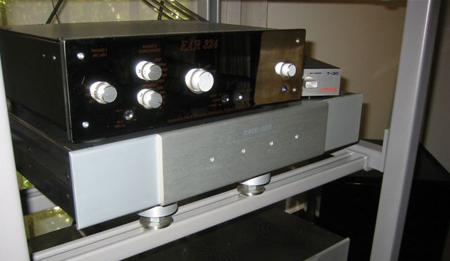
Quite a few visitors to my listening room thought that the Zero One components looked very nice. Nobody mistook them for anything other than a CD transport and DAC. The build quality of both units is quite bold for a first-generation product. Both have faceplates machined from solid blocks of aluminum. The cases seem almost over-engineered—in a good sense—with heavy-duty bases and solid aluminum shielding around critical interior components. In PC style, one large-diameter ball bearing fan is mounted inside the case to assist in airflow and cooling. It was not audible unless I stuck my ears a few inches from the case. Centered in the middle of the Ar38's half-inch-thick faceplate is the Toshiba-sourced CD-ROM drive and a large, backlit 4-by-8-inch display, and a small remote control eye occupies the remaining real estate. The Ar38 DAC is built to similar, though less hefty proportions, with only four blue-light-emitting diodes indicating power status, digital signal lock, and I2S or SPDIF operation gracing the beautiful face. The natural state of the DAC is a permanent ON, while the transport/archiving deck has a main power switch plus a computer-derived pushbutton power switch that actually turns the unit on. Both units feature IEC outlets, allowing tweaking by replacing the power cords. A generic plastic remote control rounds out the package. Some people might find it annoying that, unlike your basic CD player, there are no controls on either unit, which means that the remote is essential. For this reason, Zero One provides TWO remotes, in case you lose or break one.
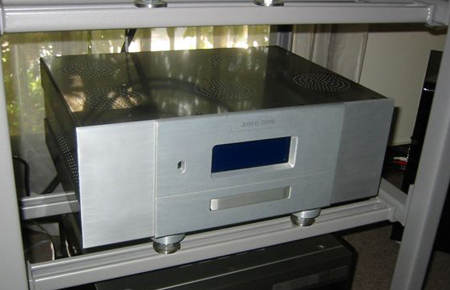
Setup was a breeze, although I had to adjust the bars and mounts on the exceptional EquaRack (review forthcoming). I used my usual Audio Magic power cords on both units, and Audio Magic interconnects from the DAC to my E.A.R. line stage. I connected the Ti48 and Ar38 with the I2S link. Turning on the transport was almost like turning on a computer—pressing the power button on the back causes the hard drives to spin up and boots a Linux-derived Kernel. About thirty seconds later, the display reads "CD player" and "Track" and you are ready to play your first disc. The disc tray can only be opened by pressing the Eject button on the remote, so keeping the remote handy is a must. The sonically superior Toshiba-sourced CD-ROM drive will only read standard CDs. This is the first commercial CD player I have come across that refuses to read the CD layer of SACD hybrid discs—a pity, since quite a few of the CDs that I regularly listen to are hybrid discs, including the new RCA and Mercury SACD reissues. Alvin Heng told me that playing hybrid SACDs derived from Sony/Philips was not a top priority for Toshiba, which is one of the developers of DVD and DVD-A technology, and that a simple firmware update to the drive logic would solve the problem. So far, no such update has been released, nor is it in sight.
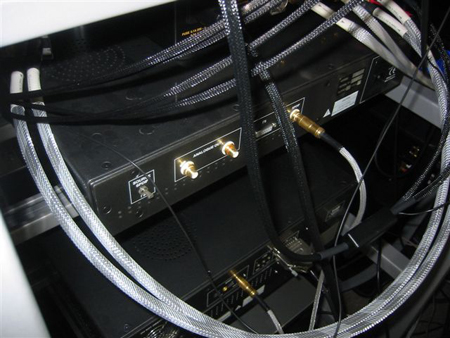
Courtesy of the FreeDB database included in the Ti48, hundreds of thousands of titles can be stored in the operating system's portion of the hard drive, and most CDs will display their title and track information. The inclusion of FreeDB (which should not be confused with the typical CDDB system featured in most commercial CD-ripping software such as iTunes) is quite clever, since manually adding this information would be cumbersome to say the least, and with up to 500gb of storage—and more on the way—storing thousands of CDs with incorrect or missing track/title information could be a fatal flaw. This reflects the amount of R&D that Alvin Heng and his crew put into making sure the unit is as clever and future-proof as it needs to be. Since the backbone of the unit is a Linux-derived operating system, upgrades are only a CD-ROM away. This could be something as simple as an updated FreeDB database or a complete rewrite of the user interface. Keeping in mind that this is really a CD player with a computer operating system and interface, the possibilities are essentially limitless, but therein lies the dilemma. Make the user interface too computer-like (icon-based, like OSX or WinXP) and you need an outboard screen to display information. Make the user interface a simple, letter-based design and you run the risk of oversimplifying things to the point of major frustration.
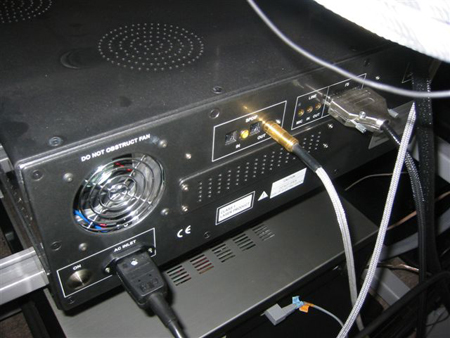
Providing attachments for a monitor has other shortcomings. A separate circuit would have to be fed with a video card, which would yield mains pollution and further noise. From the outset, the plan was to incorporate a static LCD display that would only provide the user with the information absolutely needed. One of the things that sets the iPod apart from the competition is its intuitive, letter-based interface, which allows you to quickly do what you need to do with the help of a display similar to the Ti48's. The essential operations of the Ti48/Ar38 resemble those of the iPod. Apart from having a ten-base keypad that is also doubling as the alphanumeric input (for later editing if you so chose), it also features a simple four-vector keypad with an "OK" button in the center that is essentially the "Enter" key. Any function available to the user can be accessed via this remote. The menu system is clearly laid out, with a logical sequence of operation. The first tab shows "CD Player." Next in line is "HD Player," followed by "HD Editor." The remaining three deal with the output settings, system setup, and a very computer-esque "Shutdown," which is essentially the main power switch when you want to turn the unit off.
Playing a CD is achieved by selecting "Play" on the remote. The Ti48's functions are pretty much identical to those of a CD player—pause, play, previous track, next track, track selection, etc. are all easily identified via the remote. One of Alvin's paramount objectives was to make users feel at home with the transport from day one. Provided you have your Ti48 linked to the Ar38 via the I2S cable (the significance of this cable standard is that it keeps clock data separate from the audio stream, in an effort to keep jitter and interference as low as possible), the CD player and playback from the HD (once archived) can both be set at their maximum levels of upsampling via the Burr Brown PCM 1704 chips: 24/192. The beauty of the Zero One system lies in the full customizability of any of the following: (1) The digital filter can be set from none to purist and three other HQ1-HQ3 modes (HQ3 represents standard Redbook CD playback via brickwall filter); (2) You can select four different dither settings: none, TPDF, Nshape, and Nyquist; (3) The word length can be changed from 16- to 18-, 20-, and 24-bit resolution; and (4) You can invert the absolute phase. There is a mind-boggling number of playback possibilities, perhaps too many to choose from! In keeping with the simple operation of the unit, Zero One could have limited the user-accessible options to a handful of settings, particularly since the owner's manual notes that some settings can adversely affect sound quality, but alas, audiophiles should be rejoice as they can tweak the sound to their hearts content. Spinning some of my reference discs quickly showed that setting the word length and upsampling rate to their respective maximums of 24-bit and 192kHz resolution offered the best sound. (I suppose that some of my 800 or so discs may have benefited from different settings, but I did not have a chance to try them all.) Playing around with the dither and filter settings did offer enhancements of one form or another, depending on the disc (and curiously, sometimes depending on whether the track was being played on the CD-ROM transport or the hard disc).
 As soon as my favorite demo CD, Yello's
The Eye, was
correctly identified, I spun track 9, "Time Palace," and boy, was I in for a
surprise! I had expected the unit to sound no better than a decent CD player.
After all, Zero One is an upstart company tackling what may be the most
difficult of all problems, digital playback, and to top it off, made it a
hard-disc music server. Several of my informed sources have told me that many
companies grasping for the forefront of digital playback are considering using
hard drives. For some reason, playing bits off a hard drive yields improvements
in jitter level and signal retrieval, to the point of yielding an unprecedented
quality of music playback. The prevailing theory is that the transport section
of a hard drive is of much higher mechanical precision than any
silver-disc-based transport. Also, the buffer stage of every hard drive
(anywhere from 2mb to a whopping 16mb) somehow aids in information retrieval.
Within seconds, I noticed the tremendous spatial cues that the Ti48/Ar38 combo
was throwing into my room. I had not heard such an enveloping soundstage since
my days with the outstanding Modwright-modified Sony 999ES DVD/SACD/CD player.
This was a real treat. Not only was the soundstage fully lit, but it was also
far deeper than that of any other CD player I had had in my system until then,
excluding the Modwright/Sony.
As soon as my favorite demo CD, Yello's
The Eye, was
correctly identified, I spun track 9, "Time Palace," and boy, was I in for a
surprise! I had expected the unit to sound no better than a decent CD player.
After all, Zero One is an upstart company tackling what may be the most
difficult of all problems, digital playback, and to top it off, made it a
hard-disc music server. Several of my informed sources have told me that many
companies grasping for the forefront of digital playback are considering using
hard drives. For some reason, playing bits off a hard drive yields improvements
in jitter level and signal retrieval, to the point of yielding an unprecedented
quality of music playback. The prevailing theory is that the transport section
of a hard drive is of much higher mechanical precision than any
silver-disc-based transport. Also, the buffer stage of every hard drive
(anywhere from 2mb to a whopping 16mb) somehow aids in information retrieval.
Within seconds, I noticed the tremendous spatial cues that the Ti48/Ar38 combo
was throwing into my room. I had not heard such an enveloping soundstage since
my days with the outstanding Modwright-modified Sony 999ES DVD/SACD/CD player.
This was a real treat. Not only was the soundstage fully lit, but it was also
far deeper than that of any other CD player I had had in my system until then,
excluding the Modwright/Sony.
 The Zero One combo's presentation was very much in
the room, stretching from before the speakers to well past the rear walls. The
bass had great power and authority, though it sounded a bit thick and slightly
bloated. Dynamics also seemed slightly compressed—the punch I typically get from
this disc wasn't quite happening. Playing another reference disc, Duke
Ellington's Piano in the Foreground, yielded a similarly expansive soundstage
and great detail, yet the presentation was slightly lacking in pace and punch.
While the piano sounded quite like a piano, it didn't have the fluid dynamics I
typically hear on this disc, and far less than the LP reissue played on my Brinkmann/Audio-Craft/Shelter/E.A.R. rig. (Then again, nothing digital has come
close to that package.) Changing the digital filter settings from HQ1 to none
brought a slight improvement to sound of the piano, but the soundstage was not
as expansive as before. Playing a few more discs with similar results, I
increasingly felt the urge to give up these attempts at besting the secondary
mode of operation on the Ti48. It was time to do something far more devilish—rip
a CD onto the hard drive—and hear what this thing is really all about.
The Zero One combo's presentation was very much in
the room, stretching from before the speakers to well past the rear walls. The
bass had great power and authority, though it sounded a bit thick and slightly
bloated. Dynamics also seemed slightly compressed—the punch I typically get from
this disc wasn't quite happening. Playing another reference disc, Duke
Ellington's Piano in the Foreground, yielded a similarly expansive soundstage
and great detail, yet the presentation was slightly lacking in pace and punch.
While the piano sounded quite like a piano, it didn't have the fluid dynamics I
typically hear on this disc, and far less than the LP reissue played on my Brinkmann/Audio-Craft/Shelter/E.A.R. rig. (Then again, nothing digital has come
close to that package.) Changing the digital filter settings from HQ1 to none
brought a slight improvement to sound of the piano, but the soundstage was not
as expansive as before. Playing a few more discs with similar results, I
increasingly felt the urge to give up these attempts at besting the secondary
mode of operation on the Ti48. It was time to do something far more devilish—rip
a CD onto the hard drive—and hear what this thing is really all about.
The process is simple. You press the OPTS (Options) key on the remote, and a submenu opens up with the command "Grab Album." You are essentially done, as the machine does the rest. Each album is copied at approximately four times real speed, and unlike the default iTunes software (which is preset at 128kps AAC, though users can easily change that to AIFF or lossless), it makes a digital 1:1 copy of the CD. In plain terms, this means that a 60-minute CD will take about fifteen minutes to copy, and if the original has, say, 650mb of data, the clone will have the exact same amount. Unfortunately, two annoying, though presumably fixable issues arose during this process. The first is something that occurs with all operations of the Ti48—the display only lights up for ten seconds, with no way to adjust the timing. A simple press of the remote will fire it up again, but I found this annoying at times. The second issue is that the unit doesn't tell you when the CD has been successfully "grabbed," and it is up to you to keep track. Coupled with the fact that the display went off after every ten seconds of non-use, I found myself clicking the remote many times during the grabbing process in order to check the machine's progress. This is easily fixed, and may not even be noticed by other users. You can omit certain tracks from being archived, but I found the process somewhat cumbersome, so I usually made complete copies of CDs, then simply skipped the tracks I didn't want to hear. You can also rearrange or rename tracks, delete albums, and so on via the HD Editor menu under the main menu, but I also found that a bit complicated, as I am accustomed to the simple drag-and-drop editing in iTunes. Someone not so accustomed to using iTunes will probably not have any issues with the editing mode, since it isn't really complicated.
After copying the same Yello album and cueing up the same track, nothing prepared me for what I was about to hear. Every CD player should have a built-in hard drive! The last time I got this excited about the sound of an audio product was when I heard the Modwright/Sony CD player, almost a year ago. Suddenly, dramatically, the music coming from my blond Swedish bombshells was so much better than the regular CD playback of the same unit that I was nearly gasping for air! The track suddenly had a whole new lease on life. Dynamics were explosive, the Velodyne DD15 was getting in the groove, but most importantly, there was a sense of flow that simply wasn't happening before. Rhythm became tangible, and developed a lifelike presence. Everything literally jumped at me from total blackness. Wow! Moving along to the Duke Ellington piece, it seemed as if I were playing a different recording. The dynamics of the piano sounded real, and resembled what I had heard from the Modwright/Sony. The sound had improved to the point that I could happily live with this unit if it weren't for the Modwright/Sony.
I then began to wonder how far the level of performance could be taken. Switching to Nshape playback from the menu, I was able to achieve ever-so-slightly better piano sound. It was a subtle yet audible improvement in impact and definition. What the Ti48 does off the hard drive was real, and verifiable with each disc I played. The sound was simply more real, with less listener fatigue and more analog character. Disc after disc offered new perspectives of this technology, with the only real shame the fact that I wasn't able to play any of my favorite classical hybrid SACDs. The Ti48/Ar38 combo deserves a special place in today's world of ever-escalating cost-no-object designs. It offers real-world analog performance at a real-world price. Coupled with the 30-day in-home trial, what more could you ask? Aside from the few quibbles I have with the combo, it is a testament to the ingenuity and the steadfast insistence of Alvin Heng that it plays in the league it does. I would have loved to see a remote control that replicated the display on the Ti48, but improvements are always possible, and this wasn't meant to be a no-holds-barred system, but a solid component for day-to-day use. On that, the Ti48/Ar38 combo delivers in spades. Like the iPod, future generations of Zero One components will no doubt offer more features and value for your money.
I will sorely miss this combo after it is packed up shipped to the next reviewer. Having super sonics at the tip of my finger without the need to actually change CDs is something I have gotten used to with the iPod, for better or worse. Offering an audiophile-grade component with that much convenience is a sure thing for people of my generation, who are used to hard-drive-based music players. Alvin Heng, Tom Browne, and David Broadhurst deserve credit for seeing their opportunity and acting on it. Danny Kaey
Ti48 Archival CD Transport
Retail: $2480 USD
Ar38 DAC
Retail: $1480 USD
Zero One
web address:
http://www.zerooneaudio.com
A number of months after this review ran, Danny became the US Importer/Distributor for Zero One through conversations with Alvin Heng.
